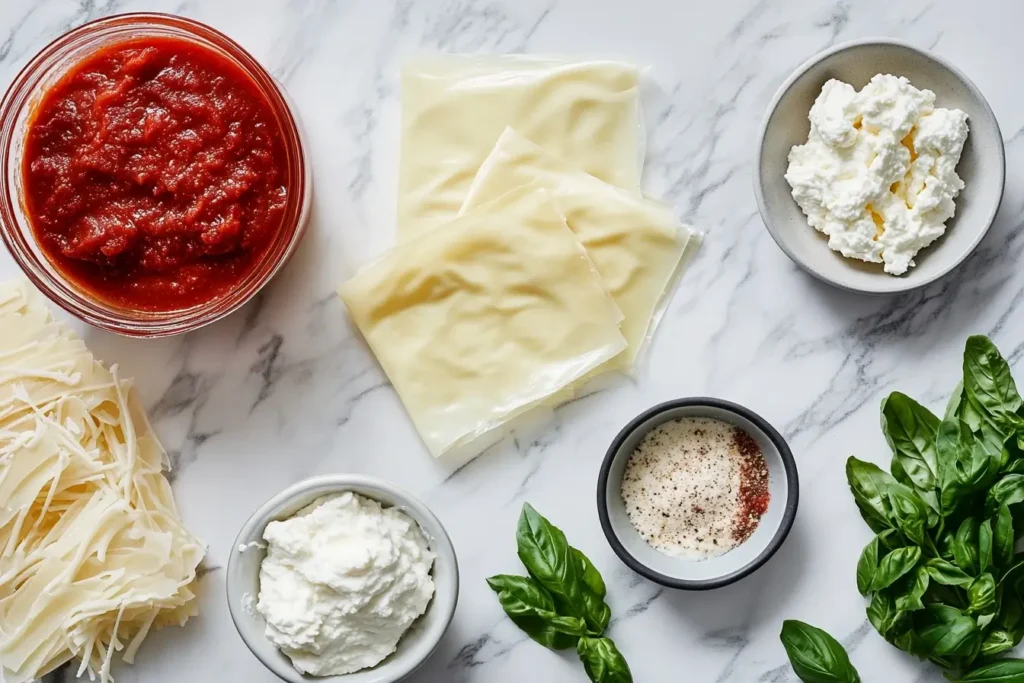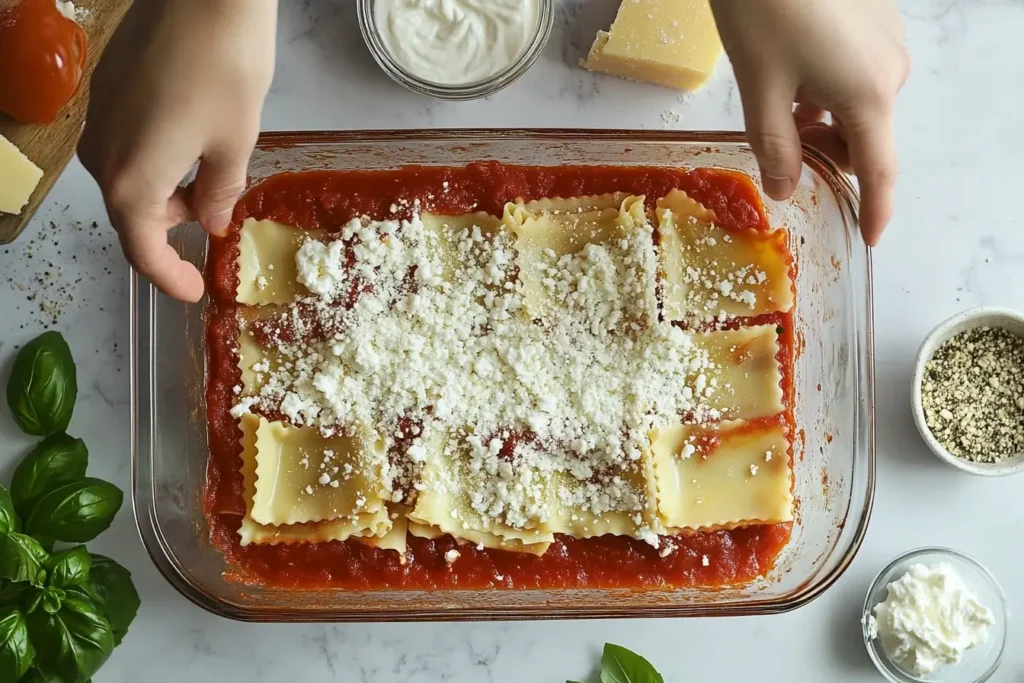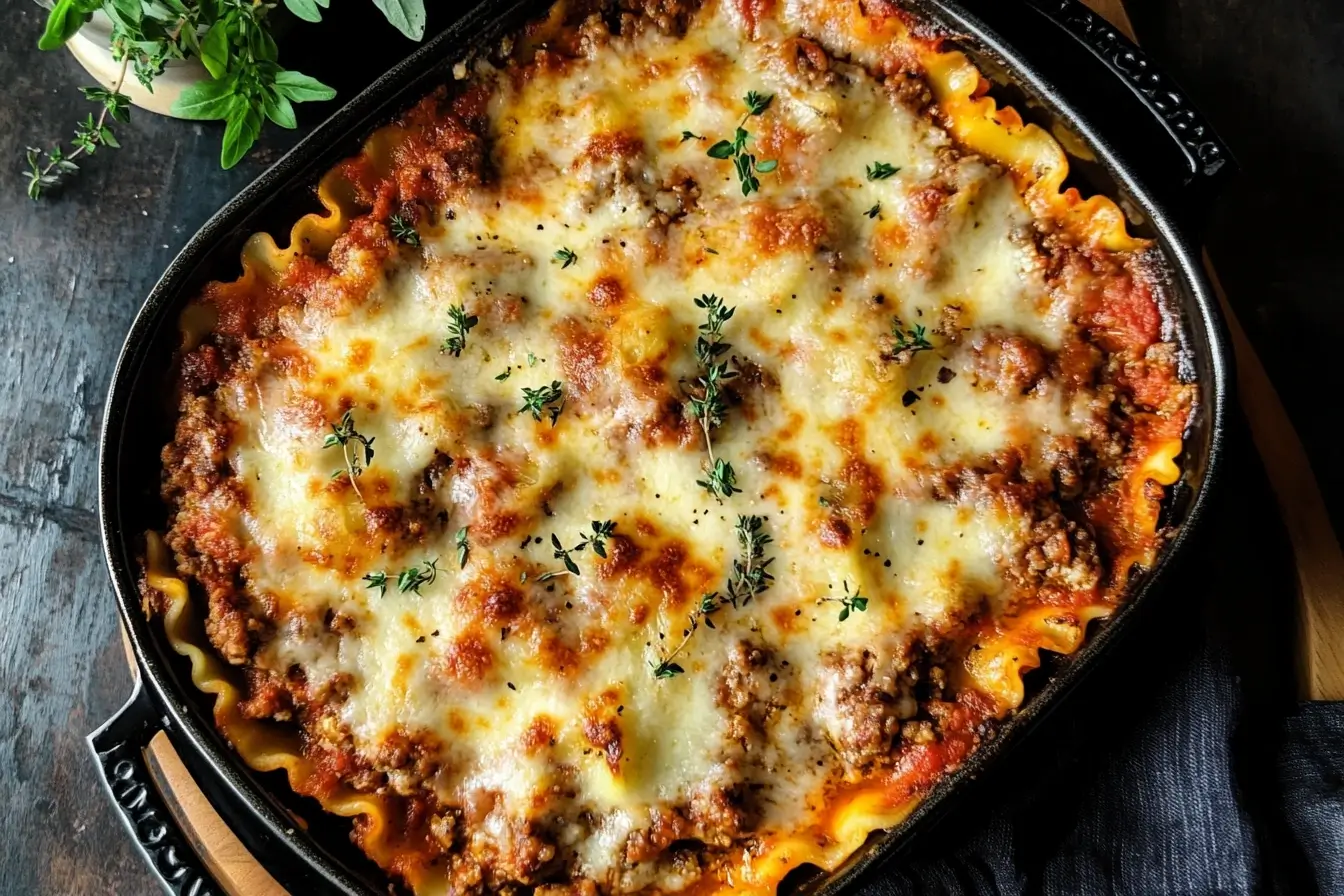If you love lasagna but don’t have the time to prepare a traditional version, this lazy lasagna recipe is the perfect solution. With its simplified approach, this recipe delivers all the comforting flavors of a classic lasagna—rich tomato sauce, gooey cheese, and tender pasta—without the hassle. Perfect for busy weeknights or as a stress-free meal prep option, this quick and easy lasagna recipe is ideal for anyone looking to enjoy a hearty, homemade dish with minimal effort.
What Is Lazy Lasagna?
How It Differs from Traditional Lasagna
Traditional lasagna is a time-intensive dish that often involves making pasta from scratch, simmering homemade sauces, and carefully layering the components for even cooking. While these steps produce a rich, authentic lasagna, they can be impractical for those with limited time or experience in the kitchen.
By contrast, a lazy lasagna recipe prioritizes speed and simplicity without compromising on flavor. Store-bought ingredients like oven-ready lasagna sheets, jarred marinara, and pre-shredded cheese reduce prep time significantly. Despite its convenience, lazy lasagna still delivers the hearty, cheesy layers and robust flavors that make the dish so beloved.
The Origins of Lazy Lasagna
The concept of lazy lasagna emerged during the mid-20th century, a time when convenience cooking gained popularity. As pre-packaged foods became more readily available, home cooks began adapting complex recipes to suit their modern lifestyles.
Lazy lasagna became a staple for busy families, college students, and anyone looking for an easier way to enjoy this classic comfort food. Over time, the recipe has evolved to include options for diverse dietary needs, such as gluten-free and vegan versions. Today, it remains a testament to the art of convenience cooking, proving that delicious meals don’t always require hours in the kitchen.
Ingredients for a Perfect Lazy Lasagna Recipe
Essential Ingredients

A successful lazy lasagna relies on a few core ingredients:
- Oven-ready lasagna sheets: These pre-cooked sheets eliminate the need for boiling, saving time and effort.
- Cheese: A combination of mozzarella, ricotta, and Parmesan creates the creamy, gooey layers lasagna is known for. Cottage cheese is an excellent alternative to ricotta for a lighter or more affordable option.
- Marinara sauce: A high-quality jarred sauce serves as the flavorful base. You can also use Alfredo sauce or mix the two for a creamy tomato flavor.
- Seasonings: Garlic powder, oregano, basil, salt, and pepper are essential for enhancing the dish’s flavor.
Optional Add-Ins
While the basic recipe is simple, you can customize your lazy lasagna with a variety of add-ins:
- Proteins: Ground beef, sausage, shredded chicken, or plant-based proteins like lentils or crumbled tofu.
- Vegetables: Spinach, zucchini, mushrooms, bell peppers, or eggplant add nutrition and texture to the dish.
Ingredient Substitutions for Special Diets
One of the best things about lazy lasagna is its adaptability. Here are some substitutions for common dietary needs:
- Gluten-free options: Use gluten-free lasagna sheets or replace them with thinly sliced vegetables like zucchini or eggplant.
- Vegan alternatives: Replace dairy cheese with plant-based versions and ensure the marinara sauce contains no animal products.
- Low-fat choices: Opt for part-skim ricotta, low-fat mozzarella, and reduced-sodium marinara to create a lighter version of the dish.
Step-by-Step Guide to Making Lazy Lasagna
1. Preparing Your Ingredients
Before assembling your lasagna, take a few minutes to prep your ingredients:
- Sauce: Pour your marinara into a bowl and stir in any additional seasonings or cream for a richer flavor.
- Cheese: Combine ricotta or cottage cheese with garlic powder, salt, pepper, and dried herbs. This step enhances the overall flavor of the dish.
- Add-ins: Cook any meat or vegetables you plan to use. Lightly sautéed veggies work best to prevent excess moisture from seeping into the lasagna.
2. Assembling the Lasagna

The layering process for lazy lasagna is simple and stress-free:
- Start with sauce: Spread a thin layer of marinara on the bottom of a baking dish. This prevents the pasta from sticking and ensures even cooking.
- Add pasta sheets: Arrange oven-ready lasagna sheets over the sauce, trimming them if necessary to fit the dish.
- Spread cheese: Add a layer of seasoned ricotta, followed by shredded mozzarella and Parmesan.
- Include add-ins: Add a layer of cooked meat or vegetables for extra flavor and texture.
- Repeat layers: Continue layering pasta, sauce, cheese, and add-ins until all ingredients are used. Finish with a top layer of sauce and cheese to create a golden, bubbly crust during baking.
3. Baking the Lasagna
- Preheat your oven to 375°F (190°C).
- Cover and bake: Use aluminum foil to cover the dish, trapping steam to cook the pasta evenly. Bake for 25-30 minutes.
- Uncover and finish: Remove the foil and bake for an additional 10-15 minutes to brown the top layer. For an extra-crispy crust, broil for 2-3 minutes, keeping a close eye to prevent burning.
- Let it rest: Allow the lasagna to cool for 10-15 minutes before serving. This step helps the layers set, making it easier to slice and serve.
Avoid Common Mistakes
Even with a simplified recipe like lazy lasagna, there are a few key pitfalls that can impact the final result. Avoid these common mistakes to ensure your lasagna turns out moist, flavorful, and perfectly cooked every time:
- Not Enough Sauce: One of the most common issues with lasagna is dryness, often caused by using too little sauce. Sauce plays a crucial role in hydrating the pasta sheets during baking and binding the layers together. When assembling your lasagna, don’t skimp on the marinara—ensure that each layer of pasta is generously coated. A tip to maintain balance is to use approximately 1 to 1.5 cups of sauce per layer, depending on the size of your baking dish.
- Skipping Pre-Cooking: Raw ingredients like ground meat or dense vegetables can lead to uneven textures and undercooked layers. Always pre-cook these elements to avoid disappointment. For example, brown ground beef or sausage in a skillet with garlic and onions before adding them to the dish. Similarly, sauté vegetables like mushrooms, zucchini, or spinach to remove excess moisture, which could otherwise make your lasagna watery.
- Overbaking: While baking is essential for melding the flavors and achieving that signature golden crust, overbaking can dry out the cheese and pasta. Stick to the recommended time (usually 35-45 minutes) and keep an eye on the top layer during the final 10 minutes. For an extra touch of control, cover the dish with foil for most of the baking time, removing it only during the last 10-15 minutes to let the cheese brown.
Enhance the Flavor
Lazy lasagna is a forgiving recipe, but a few simple tweaks can elevate it from good to exceptional. Here are some tips to boost the flavor and make each bite unforgettable:
- Season Each Layer: Don’t rely solely on the marinara sauce to carry the dish. Sprinkle garlic powder, dried basil, oregano, or even red pepper flakes onto the ricotta mixture and meat layers. For a sophisticated touch, add a small pinch of nutmeg to the ricotta—it’s a subtle trick that enhances the creaminess and depth of flavor.
- Garnish with Fresh Herbs: Fresh herbs like basil or parsley not only add a pop of color but also bring a vibrant, aromatic finish to your lasagna. Chop them finely and sprinkle on top just before serving for maximum freshness. You can also tuck a few fresh basil leaves into the layers for an added burst of herbal flavor.
- Experiment with Cheeses: While mozzarella, ricotta, and Parmesan are the classic choices, there’s no rule against experimenting with other cheeses. Smoked mozzarella adds a subtle smoky flavor, provolone provides a slightly sharper edge, and a small amount of crumbled blue cheese can create an unexpected but delightful twist. If you’re feeling adventurous, try layering in goat cheese or gruyere for added creaminess and complexity.
Creative Variations for Your Lazy Lasagna Recipe”
For a hearty, meat-free lasagna, vegetables take center stage. Here’s how to make the perfect vegetarian version:
- Layer Vegetables: Use a variety of vegetables to add depth and texture. Sautéed spinach, thinly sliced zucchini, mushrooms, bell peppers, and roasted eggplant work wonderfully. These ingredients add not only flavor but also nutrients, making the dish lighter but still satisfying.
- Boost Protein: For extra protein, consider adding lentils or crumbled tofu to one of the layers. Season them with Italian herbs to complement the marinara sauce.
- Cheese Options: Stick with traditional ricotta, mozzarella, and Parmesan, or experiment with plant-based cheeses if you’re preparing a vegan version.
This vegetarian option is hearty enough to please meat lovers while offering a fresh, wholesome twist on the classic.
Meat Lover’s Lazy Lasagna
If you’re a fan of bold, savory flavors, this variation is perfect for you. A meat lover’s lasagna combines multiple proteins for a rich and satisfying dish:
- Choose Your Proteins: Ground beef, Italian sausage, and crumbled bacon are popular choices for this version. For a smoky twist, you could even add diced ham or smoked turkey.
- Season Well: Brown the meats with minced garlic, diced onions, and Italian herbs like oregano, thyme, and rosemary for an aromatic base layer. For extra flavor, deglaze the pan with a splash of red wine or beef broth before layering the meat into the lasagna.
- Meat Sauce: Consider mixing the cooked meat directly into the marinara sauce for a consistent, hearty flavor in every bite.
This protein-packed lasagna is perfect for anyone looking to indulge in a savory, filling meal.
Gluten-Free Lazy Lasagna
Whether you’re avoiding gluten for health reasons or simply exploring lower-carb options, this gluten-free variation is both delicious and easy to prepare:
- Swap the Pasta: Gluten-free lasagna sheets are widely available and cook similarly to traditional pasta. Alternatively, use thin slices of zucchini or eggplant in place of the pasta layers. For best results, salt the vegetable slices and let them sit for 10-15 minutes to draw out excess moisture, then pat them dry before layering.
- Thick Sauce: To prevent a watery lasagna, ensure your marinara sauce is thick and doesn’t have excessive liquid. You can simmer the sauce on the stovetop for a few minutes to reduce it if needed.
- Creative Cheeses: Focus on the creamy cheese layers to ensure the dish feels indulgent even without traditional pasta. Ricotta, mozzarella, and Parmesan are staples, but you can also experiment with cheeses like cheddar or gouda for a unique twist.
This variation ensures that everyone, regardless of dietary restrictions, can enjoy the comforting flavors of lasagna.
Frequently Asked Questions About Lazy Lasagna
What is the correct way to layer lasagna?
First, start with a thin layer of sauce at the bottom of your baking dish. This ensures that the pasta sheets don’t stick during baking. Next, add a layer of pasta, followed by a generous amount of cheese. If you’re including additional fillings like meat or vegetables, spread them evenly over the cheese. Repeat these layers until you’ve used all the ingredients. Finally, top it off with a layer of sauce and a generous sprinkle of cheese to achieve a golden crust.
How can I make lazy lasagna more flavorful?
To make your lazy lasagna recipe more flavorful, it’s important to season each layer. For instance, sprinkle garlic powder, dried herbs, and pepper on the ricotta mixture to enhance its taste. Furthermore, garnishing the baked lasagna with fresh herbs like basil or parsley adds a bright and aromatic finish. Additionally, using a mix of cheeses—such as smoked mozzarella, provolone, or Parmesan—can add depth and complexity to the dish.
What should I avoid when making lazy lasagna?
There are a few common mistakes to avoid when preparing a lazy lasagna recipe. First and foremost, don’t under-sauce the dish, as this can lead to dryness. Additionally, skipping pre-cooking meats or vegetables is another pitfall, as raw ingredients may not cook properly during baking. Finally, be cautious not to overbake the lasagna, as this can cause the pasta and cheese to dry out.
Why do some recipes call for milk in lasagna?
Milk is often used in traditional béchamel sauce because it adds creaminess and helps balance the acidity of tomato sauce. Similarly, in a lazy lasagna recipe, you can achieve a comparable effect by mixing cream or milk into the ricotta layer. This step not only enhances the texture but also ensures a smoother and more cohesive flavor profile.
Conclusion
Why You’ll Love This Lazy Lasagna Recipe
This lazy lasagna recipe offers the perfect balance of convenience and flavor, making it ideal for busy schedules or weeknight dinners. With its simple preparation and customizable options, it’s a dish that can suit any taste or dietary need.
Customizable and Delicious
Whether you’re a fan of vegetarian dishes, a meat lover, or need a gluten-free option, this recipe is versatile enough to accommodate everyone. Try it today and enjoy a comforting meal that’s as easy to make as it is delicious! lazy lasagna recipe today—it’s comfort food made easy!
Explore More Delicious Recipes
Looking for more quick and easy meals? These recipes are perfect for your busy days:
- Easy Meatless Baked Ziti Recipe – A comforting and cheesy dish ready in no time.
- Homemade Beefaroni Recipe – A nostalgic one-pot meal that’s quick and satisfying.
- Classic Southern Cornbread Recipe – A simple and delicious side to pair with your lasagna.

